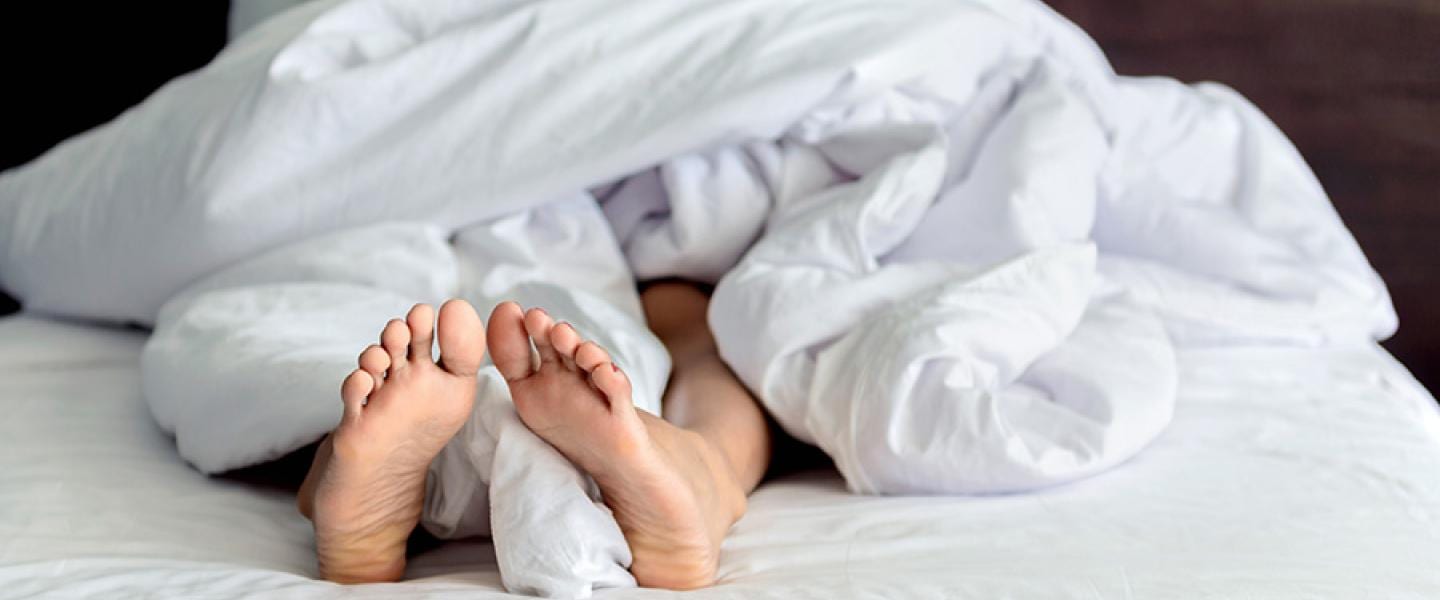When you buy through our links, we may earn a commission. Products or services may be offered by an affiliated entity. Learn more.
Sleep-Related Breathing Disorders
An overview of the types of breathing problems that can arise during sleep
Sleep-related breathing disorders are conditions of abnormal and difficult respiration during sleep, including chronic snoring and sleep apnea. Some sleep-related breathing disorders have limited health impact, but others can have serious consequences because of their potential effects on sleep and the balance of oxygen and carbon dioxide in the blood.
The American Academy of Sleep Medicine (AASM) identifies several types and subtypes of sleep-related breathing disorders. The symptoms, severity, causes, and treatment of sleep-disordered breathing varies based on the type. In complex cases, a person may be diagnosed with more than one type.
Obstructive Sleep Apnea in Adults
Obstructive sleep apnea (OSA) is one of the most common and serious sleep-related breathing disorders. In OSA, the airway repeatedly collapses during sleep, causing lapses in breathing that both fragment sleep and affect the body’s oxygen levels. Upper airway resistance syndrome (UARS) is a milder form of OSA in which sleep is disrupted but oxygen levels are not affected to the same degree.
OSA may affect as many as 30% of adults and is more common in men than women . The condition is likely underdiagnosed , and many experts anticipate that its prevalence will increase in the future along with growing rates of obesity, which is one of the major risk factors for OSA .
Snoring, gasping or choking during sleep, and excessive daytime sleepiness are central symptoms of OSA. When left untreated, the condition can cause significant health problems including cardiovascular issues like high blood pressure and stroke. A range of treatment options are effective in addressing obstructive sleep apnea and reducing its symptoms.
Obstructive Sleep Apnea in Children
Obstructive sleep apnea occurs in infants and children although considerably less often than in adults. It is estimated to affect 1-5% of children of all ages .
Compared to adults, children are more likely to have OSA that is related to enlargement of the tonsils and adenoids, which are masses of tissue at the back of the throat that are part of the immune system. For this reason, surgery, specifically removal of the adenoids and tonsils (adenotonsillectomy), is more frequently part of treatment for pediatric OSA. In addition, OSA goes away on its own in some children as they get older, so the condition does not always require immediate treatment.
Central Sleep Apnea
In central sleep apnea (CSA), lapses in respiration during sleep occur because of a lack of effort to breathe. This happens when either the brain does not properly send signals to the respiratory muscles or the respiratory muscles don’t activate in response to the brain’s signals.
In this way, central sleep apnea is distinct from obstructive sleep apnea, but people can have symptoms of both conditions at the same time. In addition, sometimes the treatment for OSA triggers CSA, which is called treatment-emergent central sleep apnea .
CSA is much less common than OSA, affecting just under 1% of people over the age of 40 . It is more common in males and in people who are over 65.
There are different types of CSA based on the nature of the underlying problem preventing proper respiration. Some established risk factors include cardiovascular problems, use of narcotics, and high altitude, but not all cases are tied to these issues. A key focus of treatment for central sleep apnea is addressing its underlying cause.
Take Our Quiz to Know Your Sleep Apnea Risk
To understand if you could have sleep apnea, take our short quiz below to see if you exhibit any signs.
Sleep-Related Hypoventilation Disorders
Sleep-related hypoventilation disorders involve elevated blood levels of carbon dioxide during sleep that result from a lack of air moving in and out of the lungs.
This insufficient breathing is commonly tied to other health problems. Often, people with sleep-related hypoventilation disorders have lung conditions like chronic obstructive pulmonary disease (COPD) or pulmonary hypertension. Disorders that affect the nervous system and some types of medications can also affect breathing and trigger hypoventilation.
A specific type of sleep-related hypoventilation disorder is called obesity hypoventilation syndrome (OHS) . This condition can occur in obese patients and normally co-occurs with obstructive sleep apnea. It is frequently associated with poor sleep and can lead to detrimental effects on the cardiovascular system.
Many people with sleep-related hypoventilation disorders struggle to breathe properly when they are awake, but the problem normally intensifies during sleep. As with central sleep apnea, treatment for sleep-related hypoventilation disorders is often directed at managing an underlying illness contributing to breathing problems.
Sleep-Related Hypoxemia Disorder
Hypoxemia is a low level of oxygen in the blood. Sleep-related hypoxemia disorder is when oxygen concentrations drop, but the levels of carbon dioxide don’t rise high enough to cross the threshold for diagnosis as a sleep-related hypoventilation disorder.
Sleep-related hypoxemia disorder occurs mostly as the result of another health problem that affects breathing, including a number of types of lung conditions, and addressing hypoxemia frequently involves a focus on that underlying issue.

Snoring
Snoring occurs when air moves around floppy tissue near the back of the throat and causes that tissue to vibrate. Estimates hold that as many as 27% of children , 40% of adult women, and 57% of adult men snore.
Light snoring every once in a while is normal for most people and is not harmful. Snoring that occurs more than three nights per week, though, is classified as a sleep-related breathing disorder. It may be referred to as primary, chronic, or habitual snoring, and it is differentiated from frequent snoring associated with obstructive sleep apnea.
Risk factors for chronic snoring include things that either constrict the airway or cause tissue to relax. Examples include obesity, use of alcohol and sedatives, chronic nasal congestion, and sleeping on your back. Some people are more inclined to snore because of the anatomy of their mouth, nose, and throat.
The main health concern associated with snoring is the possibility that it is indicative of an underlying case of obstructive sleep apnea, so it is important to talk with a doctor if snoring occurs with other symptoms such as daytime sleepiness, recent weight gain, teeth grinding during sleep, or morning headaches.
If no other symptoms are present, the greatest impact of chronic snoring may be on a bed partner, roommate, or family members who are bothered by the noise and find it harder to sleep. Various types of treatments can be helpful in reducing snoring so that it is less bothersome to other members of the person’s household.
Catathrenia
Catathrenia is a pattern of abnormal breathing and vocalization that is often referred to as sleep-related groaning.
During episodes of catathrenia, a sleeper takes in a long inhaled breath and then exhales slowly while making a monotone, groan-like sound. As this occurs, the sleeper is not aware of the vocalizations.
Catathrenia is uncommon and does not pose any known health risks to the sleeper. However, it can be annoying or disruptive for bed partners or others within earshot. People with catathrenia may also be embarrassed about the sounds once they are made aware of the condition. When desired, treatments for obstructive sleep apnea, such as the use of a continuous positive airway pressure (CPAP) device, have achieved reductions in catathrenia episodes .

Still have questions? Ask our community!
Join our Sleep Care Community — a trusted hub of sleep health professionals, product specialists, and people just like you. Whether you need expert sleep advice for your insomnia or you’re searching for the perfect mattress, we’ve got you covered. Get personalized guidance from the experts who know sleep best.
References
13 Sources
-
American Academy of Sleep Medicine. (2014). The International Classification of Sleep Disorders – Third Edition (ICSD-3). Darien, IL
https://aasm.org/ -
Peppard, P. E., Young, T., Barnet, J. H., Palta, M., Hagen, E. W., & Hla, K. M. (2013). Increased prevalence of sleep-disordered breathing in adults. American journal of epidemiology, 177(9), 1006–1014.
https://pubmed.ncbi.nlm.nih.gov/23589584/ -
Rundo J. V. (2019). Obstructive sleep apnea basics. Cleveland Clinic journal of medicine, 86(9 Suppl 1), 2–9.
https://pubmed.ncbi.nlm.nih.gov/31509498/ -
Peppard, P. E., Young, T., Palta, M., Dempsey, J., & Skatrud, J. (2000). Longitudinal study of moderate weight change and sleep-disordered breathing. JAMA, 284(23), 3015–3021.
http://jama.jamanetwork.com/article.aspx?doi=10.1001/jama.284.23.3015 -
Rosen CL, Storfer-Isser A, Taylor HG, et al. Increased behavioral morbidity in school-aged children with sleep-disordered breathing. Pediatrics 2004; 114:1640.
https://pubmed.ncbi.nlm.nih.gov/15574628/ -
Marcus, C. L., Moore, R. H., Rosen, C. L., Giordani, B., Garetz, S. L., Taylor, H. G., Mitchell, R. B., Amin, R., Katz, E. S., Arens, R., Paruthi, S., Muzumdar, H., Gozal, D., Thomas, N. H., Ware, J., Beebe, D., Snyder, K., Elden, L., Sprecher, R. C., Willging, P., … Childhood Adenotonsillectomy Trial (CHAT) (2013). A randomized trial of adenotonsillectomy for childhood sleep apnea. The New England journal of medicine, 368(25), 2366–2376.
https://pubmed.ncbi.nlm.nih.gov/23692173/ -
Strohl, K. P. (2019, March). Merck Manual Consumer Version: Sleep Apnea.
https://www.merckmanuals.com/home/lung-and-airway-disorders/sleep-apnea/sleep-apnea -
Nigam, G., Riaz, M., Chang, E. T., & Camacho, M. (2018). Natural history of treatment-emergent central sleep apnea on positive airway pressure: A systematic review. Annals of thoracic medicine, 13(2), 86–91.
https://pubmed.ncbi.nlm.nih.gov/29675059/ -
Donovan, L. M., & Kapur, V. K. (2016). Prevalence and Characteristics of Central Compared to Obstructive Sleep Apnea: Analyses from the Sleep Heart Health Study Cohort. Sleep, 39(7), 1353–1359.
https://pubmed.ncbi.nlm.nih.gov/27166235/ -
A.D.A.M. Medical Encyclopedia. (2019, July 23). Obesity hypoventilation syndrome (OHS)., Retrieved August 27, 2020, from
https://medlineplus.gov/ency/article/000085.htm -
Zhang, G., Spickett, J., Rumchev, K., Lee, A. H., & Stick, S. (2004). Snoring in primary school children and domestic environment: a Perth school based study. Respiratory research, 5(1), 19.
https://pubmed.ncbi.nlm.nih.gov/15527500/ -
Schwab, R. (2020, June). Snoring. Merck Manual Consumer Version., Retrieved August 27, 2020.
https://www.merckmanuals.com/professional/neurologic-disorders/sleep-and-wakefulness-disorders/snoring -
Guilleminault, C., Hagen, C. C., & Khaja, A. M. (2008). Catathrenia: parasomnia or uncommon feature of sleep disordered breathing?. Sleep, 31(1), 132–139.
https://pubmed.ncbi.nlm.nih.gov/18220087/































